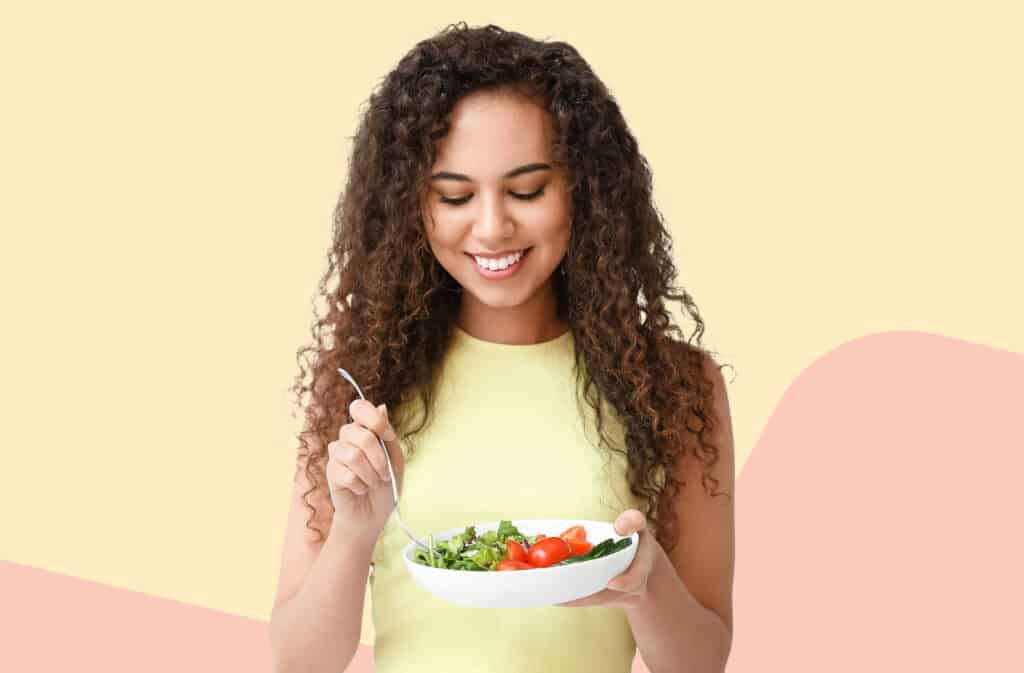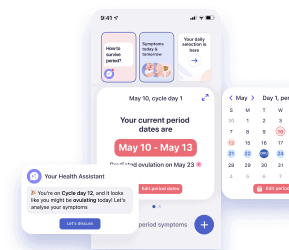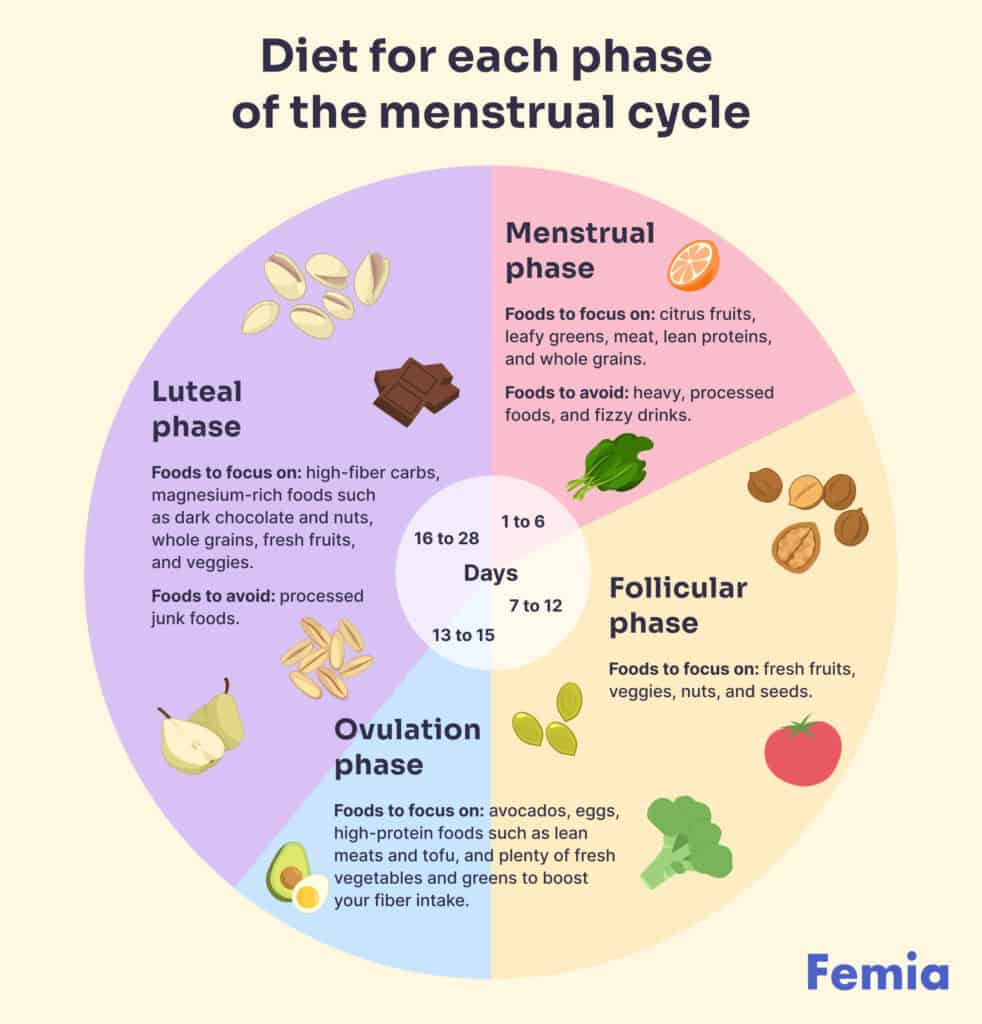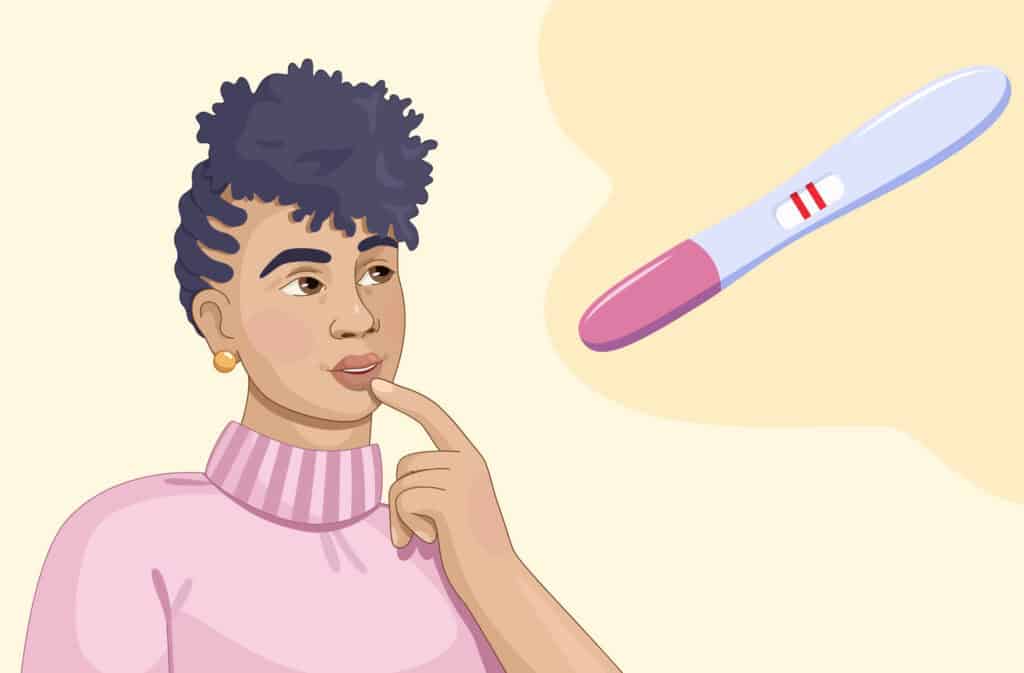Femia > Health Library > Your cycle > Health > Cycle syncing diet: What to eat during each phase of your menstrual cycle
Cycle syncing diet: What to eat during each phase of your menstrual cycle

- Updated Mar 2, 2025
- Published
CRAFTED BY HUMAN
Crafted by human At Femia, we provide accurate and up-to-date information at every stage of your journey, from trying to conceive, pregnancy and postnatal support. All content is created by a real person based on in-depth research and own professional experience. Femia ensures that you will receive expert advice, strict accuracy and a personalized approach from our authors/medical experts. Learn more about our editorial policy.
FACT CHECKED
Fact checked At Femia Health, we maintain the highest standards of editorial excellence in delivering content focused on helping you conceive, guiding you through pregnancy, and supporting you postpartum. Explore our content review principles to learn how we ensure the accuracy and quality of our health and lifestyle tips for every stage of your journey.
- Cycle syncing your diet means eating foods that complement your hormonal changes throughout your menstrual cycle.
- Focus on iron-rich foods during your period, energy-boosting fresh produce in the follicular phase, protein for ovulation, and mood-supporting foods in the luteal phase.
A cycle syncing diet contains foods to complement your natural hormonal fluctuations throughout each cycle phase. Cycle syncing doesn’t just apply to the food you eat; you can also tailor your workouts to sync with your cycle. This ensures you push yourself when your energy levels are highest and opt for gentle workouts when hormones leave you feeling fatigued.

Understanding cycle syncing
To understand cycle syncing, you must first become the expert of your own cycle. We usually describe the menstrual cycle as lasting 28 days, though it varies wildly between women. Generally, your menstrual cycle will take somewhere between 21 and 35 days each month. While some women have predictable cycles, others differ from month to month.
One reason why cycle tracking is worthwhile is that it allows you to gain an in-depth understanding of your cycle and the associated changes occurring in your body. While there is little solid science to back up cycle syncing diets, many women find them a helpful way to control their energy levels throughout the month. Remember, women’s health is notoriously underfunded, so a lack of science doesn’t necessarily mean something doesn’t work.
Phases of a menstrual cycle
The menstrual cycle has four phases. The timeframes listed below are rough suggestions—your exact cycle may vary:
- Menstrual phase (Days 1 to 6).
- Follicular phase (Days 7 to 12).
- Ovulation phase(Days 13 to 15).
- Luteal phase(Days 16 to 28).
If you want to try eating menstrual phase foods, you first need to become an expert in your cycle. Use the Femia app to track your cycle and keep note of any symptoms you experience throughout the month.
Track food cravings, energy levels, mood shifts, and bloating to see how these change throughout your cycle. You can then use this data to inform your dietary choices throughout the month. For example, once you know the bloaty points in your cycle, you can pick foods to reduce bloating.
👉Find out more: Understanding ovulation symptoms: Mood changes explained
Benefits of cycle syncing diet
A cycle syncing diet involves tailoring your nutrition to the different phases of your menstrual cycle, which can help optimize hormonal balance and overall well-being. Here are some key benefits of adopting this dietary approach:
Hormonal balance: By aligning your food choices with your menstrual cycle, you can support hormonal fluctuations, potentially reducing symptoms like mood swings, bloating, and cramping.
Enhanced energy levels: Eating according to your cycle can help manage energy dips and peaks. For example, during the follicular phase, when energy levels are higher, you might feel more motivated to engage in higher-intensity workouts.
Improved mood and mental clarity: Certain foods can help regulate neurotransmitters and mood-related hormones. A cycle syncing diet can enhance mental clarity and emotional stability throughout the month.
Better digestion: Tailoring your diet can improve digestive health. For instance, focusing on lighter foods during the luteal phase may alleviate bloating and discomfort.
Support for reproductive health: By consuming nutrient-dense foods that support ovulation and the menstrual cycle, you can enhance fertility and reproductive function.
Weight management: Cycle syncing may help with weight management by encouraging mindful eating practices that align with your body’s natural rhythms, reducing cravings and overeating.
Increased nutrient intake: Following a cycle syncing diet encourages the consumption of a variety of foods, promoting a more balanced nutrient intake and supporting overall health.
Diet for each phase of the menstrual cycle

There are four distinct phases to your menstrual cycle. While cycle syncing centers around adapting your diet to suitr the menstrual phase you are in, there is little solid scientific proof to back up this practice. However, food syncing may encourage awareness of a healthy, balanced diet and improve PMS symptoms. For example, a 2023 study published in Frontiers in Nutrition found that diet impacts PMS symptoms, but science about what foods to eat and avoid is lacking.
1. Menstrual phase: Foods to replenish and recover
The menstrual phase is the first stage of your cycle, from the first day of your period to the last. If you’re wondering what to eat during the menstrual phase, you might enjoy learning that eating foods high in iron can help combat symptoms of low iron.
During the menstrual phase, you may feel tired and bloated on your period. It’s wise to eat iron-rich foods and meals that reduce bloating. Pair iron-rich foods such as meat and legumes with vitamin C to boost your iron intake. Excellent menstrual phase foods include citrus fruits, which are excellent sources of vitamin C. Leafy greens, lean proteins, and whole grains are excellent foods to relieve menstrual symptoms. Iron-rich foods to include:
- Red meat: Beef, lamb, and liver are particularly high in heme iron, which is more easily absorbed by the body.
- Poultry: Chicken and turkey provide good sources of iron.
- Fish: Fatty fish like salmon and tuna, as well as shellfish, offer both iron and omega-3 fatty acids.
- Legumes: Lentils, chickpeas, and beans are excellent plant-based sources of iron.
- Leafy greens: Spinach, kale, and Swiss chard are rich in non-heme iron.
- Tofu: A versatile source of iron for those following a plant-based diet.
- Nuts and seeds: Pumpkin seeds, almonds, and cashews are great snacks that also provide iron.
- Whole grains: Quinoa, brown rice, and oats are good sources of iron and fiber.
- Stay hydrated and avoid fizzy drinks that may leave you bloated.
Though you may be craving the ease of processed foods, it’s best to avoid heavy, processed items that can leave you feeling worse. Cycle syncing your diet will force you to examine the foods you eat and how often you give in to cravings throughout the month. You’ll likely notice you eat more junk food during your period, but this habit may be making your symptoms worse. Try to cut down on junk foods and caffeine during this phase.
Sample menstrual phase meal plan
Day 1:
Breakfast:
- Spinach and feta omelet: Made with 2 eggs, sautéed spinach, and crumbled feta cheese. Serve with a slice of whole-grain toast.
- Citrus fruit salad: A mix of oranges and grapefruit, drizzled with honey.
Snack:
- Almonds: A small handful (about 1 oz) of raw almonds for a boost of healthy fats and iron.
Lunch:
- Quinoa salad: Quinoa mixed with black beans, diced bell peppers, cherry tomatoes, and avocado, topped with lime juice and cilantro.
- Steamed broccoli: Lightly steamed broccoli for additional vitamins and fiber.
Snack:
- Carrot and celery sticks: Served with hummus for dipping.
Dinner:
- Grilled chicken breast: Marinated in lemon and herbs, served with roasted sweet potatoes and sautéed kale.
- Side salad: Mixed greens with cherry tomatoes, cucumber, and a vinaigrette dressing.
Day 2:
Breakfast:
- Oatmeal: Cooked oats topped with sliced bananas, a sprinkle of cinnamon, and a tablespoon of pumpkin seeds for added iron.
- Green tea: A cup of green tea for antioxidants and hydration.
Snack:
- Greek yogurt: Plain Greek yogurt topped with a handful of mixed berries for added vitamin C.
Lunch:
- Lentil soup: Hearty lentil soup made with carrots, celery, and spices, served with whole-grain bread.
- Side of mixed greens: Dressed with lemon and olive oil.
Snack:
- Sliced apple with nut butter: A medium apple sliced and served with almond or peanut butter.
Dinner:
- Baked salmon: Seasoned with garlic and lemon, served with quinoa and steamed asparagus.
- Roasted brussels sprouts: Tossed with olive oil and sea salt.
Day 3:
Breakfast:
- Smoothie: Blend spinach, banana, a scoop of protein powder, and almond milk. Add a tablespoon of chia seeds for fiber.
Snack:
- Cucumber slices: Served with tzatziki for a refreshing snack.
Lunch:
- Chickpea salad: Chickpeas, diced cucumber, red onion, parsley, and a lemon-olive oil dressing.
- Whole grain pita: Served on the side.
Snack:
- Dark chocolate: A small piece of dark chocolate (70% cocoa or higher) for a treat rich in iron and antioxidants.
Dinner:
- Stuffed bell peppers: Bell peppers stuffed with a mixture of brown rice, black beans, corn, and spices, topped with cheese.
- Side of mixed vegetables: Roasted carrots and zucchini seasoned with herbs.
2. Follicular phase
As your period ends, you enter the follicular phase, which lasts until ovulation. Increasing estrogen levels during this stage mean you’re likely to feel good. If you’re wondering what to eat during the follicular phase, you may want to complement your natural energy levels during this phase. Good foods during the follicular phase include energy-boosting options like fresh fruits, veggies, nuts, and seeds.
Eating ovulatory phase foods rich in essential vitamins and minerals will ensure your body has everything it needs as you approach ovulation. A 2023 study published in Nutritional Reviews found that women’s appetites tend to wane during the follicular phase, particularly in the days preceding ovulation. Nutrient-dense foods for the follicular phase:
Fresh fruits:
- Berries (strawberries, blueberries, raspberries): High in antioxidants and vitamin C, which support immune function and collagen production.
- Citrus fruits (oranges, grapefruits, lemons): Packed with vitamin C to enhance iron absorption and boost energy.
Vegetables:
- Leafy greens (spinach, kale, arugula): Rich in iron, calcium, and vitamins A and K, supporting overall health.
- Cruciferous vegetables (broccoli, cauliflower, Brussels sprouts): Provide fiber, vitamins C and K, and support estrogen metabolism.
Nuts and seeds:
- Almonds and walnuts: High in healthy fats, protein, and vitamin E, which is important for hormone regulation.
- Chia sdeeds and flaxseeds: Excellent sources of omega-3 fatty acids and fiber, promoting heart health and digestion.
Whole grains:
- Quinoa and brown rice: Provide complex carbohydrates for sustained energy, along with B vitamins that support metabolic processes.
- Oats: A great source of fiber, vitamins, and minerals that can help regulate energy levels.
Lean proteins:
- Chicken and turkey: Good sources of protein and iron to support muscle health and energy levels.
- Fish (especially fatty fish like salmon): Rich in omega-3 fatty acids, which can help reduce inflammation and support hormone production.
Healthy fats:
- Avocado: Contains healthy monounsaturated fats, potassium, and fiber, which can help with satiety and hormone balance.
- Olive oil: A great source of healthy fats that supports heart health and can help balance hormones.
Herbs and spices:
- Ginger and turmeric: Known for their anti-inflammatory properties and can support digestion and overall health.
👉Find out more: Pelvic floor massage 101: How to relieve pain and improve function
Sample follicular phase meal plan
Day 1:
Breakfast:
- Berry smoothie bowl: Blend spinach, frozen mixed berries, banana, and almond milk. Top with sliced kiwi, chia seeds, and a handful of granola.
Snack:
- Apple slices with almond butter: A medium apple sliced and served with 2 tablespoons of almond butter.
Lunch:
- Quinoa salad: Cooked quinoa mixed with diced cucumbers, cherry tomatoes, parsley, and a lemon-olive oil dressing. Add chickpeas for extra protein.
Snack:
- Carrot and celery sticks: Served with hummus for dipping.
Dinner:
- Baked lemon herb chicken: Chicken breast marinated in lemon juice, garlic, and herbs, served with roasted sweet potatoes and steamed broccoli.
- Side salad: Mixed greens with avocado, cherry tomatoes, and a vinaigrette.
Day 2:
Breakfast:
- Overnight oats: Rolled oats soaked in almond milk overnight, topped with sliced banana, walnuts, and a drizzle of honey.
Snack:
- Greek yogurt: Plain Greek yogurt topped with a handful of fresh berries and a sprinkle of flaxseeds.
Lunch:
- Spinach and feta stuffed peppers: Bell peppers stuffed with a mixture of cooked quinoa, spinach, feta cheese, and herbs, baked until tender.
Snack:
- Trail mix: A mix of almonds, walnuts, dried cranberries, and dark chocolate pieces.
Dinner:
- Grilled salmon: Seasoned with dill and lemon, served with a side of brown rice and roasted Brussels sprouts.
Day 3:
Breakfast:
- Avocado toast: Whole-grain toast topped with smashed avocado, sprinkled with salt, pepper, and chili flakes. Serve with a poached egg on top.
Snack:
- Cucumber slices with Tzatziki: Fresh cucumber slices served with homemade or store-bought tzatziki sauce.
Lunch:
- Chickpea salad: Chickpeas mixed with diced red onion, cucumber, bell peppers, and parsley, dressed with lemon juice and olive oil. Serve over mixed greens.
Snack:
- Dark chocolate: A couple of squares of dark chocolate (70% cocoa or higher) for a satisfying treat.
Dinner:
- Stir-fried tofu and vegetables: Tofu stir-fried with a mix of colorful vegetables (like bell peppers, carrots, and snap peas) in a light soy sauce, served with quinoa or brown rice.
3. Ovulation foods: Boost protein for vitality
The ovulation phase lasts up to three days, usually two weeks before your next period. During this time, you may have a reduced appetite, making it vital to consume nutrient-dense foods that support healthy ovulation.
Focus on high-protein foods like lean meats, eggs, and tofu. Incorporate zinc-rich foods such as meat, seafood, nuts, and fortified items. This phase is ideal for high-intensity workouts, so ensure you have enough energy by including plenty of fresh vegetables and protein. There are some key foods for the ovulation phase:
High-protein foods:
- Lean meats (chicken, turkey)
- Fish (salmon, tuna)
- Tofu and tempeh
Eggs: Packed with protein and essential vitamins.
Avocados: High in healthy fats and fiber.
Nuts and seeds: Pumpkin seeds, almonds, and walnuts for protein and zinc.
Fruits and vegetables: Leafy greens (spinach, kale) and berries (strawberries, blueberries) for vitamins and antioxidants.
Whole grains: Quinoa and brown rice for complex carbohydrates.
Zinc-rich foods: Shellfish (oysters, shrimp) and legumes (chickpeas, lentils).
Sample ovulation phase meal plan
Day 1:
Breakfast:
- Berry smoothie bowl: Blend spinach, mixed berries, banana, and almond milk. Top with chia seeds and granola.
Snack:
- Apple slices with almond butter.
Lunch:
- Quinoa salad: Cooked quinoa with cucumbers, cherry tomatoes, parsley, and lemon-olive oil dressing. Add chickpeas for protein.
Snack:
- Carrot and celery sticks with hummus.
Dinner:
- Baked lemon herb chicken with roasted sweet potatoes and steamed broccoli.
- Side salad with mixed greens and avocado.
Day 2:
Breakfast:
- Overnight oats: Rolled oats soaked in almond milk topped with banana and walnuts.
Snack:
- Greek yogurt with fresh berries and flaxseeds.
Lunch:
- Stuffed bell peppers: Peppers filled with quinoa, spinach, and feta, baked until tender.
Snack:
- Trail mix: Almonds, walnuts, dried cranberries, and dark chocolate.
Dinner:
- Grilled salmon with brown rice and roasted Brussels sprouts.
Day 3:
Breakfast:
- Avocado toast: Whole-grain toast topped with smashed avocado and a poached egg.
Snack:
- Cucumber slices with Tzatziki.
Lunch:
- Chickpea salad: Chickpeas, red onion, cucumber, and parsley, dressed with lemon juice and olive oil over mixed greens.
Snack:
- Dark chocolate (a couple of squares).
Dinner:
- Stir-fried tofu and vegetables: Tofu with colorful vegetables in a light soy sauce, served with quinoa.
4. Luteal phase foods: Support your mood with nutrients
The luteal phase occurs in the lead-up to your period. During this time, you might crave sweets and experience low energy. Many women report increased appetites, often reaching for junk food. To avoid this, choose healthy proteins and complex carbohydrates that keep you full longer.
Good luteal phase foods include magnesium-rich options like dark chocolate and nuts, which can help boost mood and combat PMS mood swings. A 2023 study in Nutritional Research Reviews found that vitamin D, calcium, zinc, and curcumin may reduce menstrual symptoms.
Eating whole grains, fresh fruits, and vegetables can provide a natural energy boost. Opt for high-fiber carbs to keep your appetite in check, and choose high-protein breakfasts to prevent junk food cravings. Avoid processed foods that can cause bloating before your period. Key foods for the luteal phase:
Healthy proteins:
- Lean meats (chicken, turkey)
- Fish (salmon, sardines)
- Tofu and legumes (chickpeas, lentils)
Magnesium-rich foods:
- Dark chocolate
- Nuts and seeds (almonds, pumpkin seeds)
Whole grains: Oats, quinoa, and brown rice
Fresh fruits: Bananas, apples, and berries
Vegetables: Leafy greens (spinach, kale) and cruciferous veggies (broccoli, cauliflower)
Vitamin D and calcium sources: Fortified dairy alternatives and leafy greens
Zinc-rich foods: Shellfish, legumes, and whole grains
Luteal phase meal plan
Day 1:
Breakfast:
- Protein-packed oatmeal: Cook oats with almond milk, topped with sliced banana, a tablespoon of almond butter, and a sprinkle of cinnamon.
Snack:
- Dark chocolate and nuts: A small piece of dark chocolate (70% cocoa or higher) and a handful of mixed nuts.
Lunch:
- Quinoa bowl: Cooked quinoa with black beans, diced bell peppers, corn, and avocado, drizzled with lime juice.
Snack:
- Veggies and hummus: Carrot and cucumber sticks with hummus.
Dinner:
- Baked salmon: Salmon fillet seasoned with herbs, served with sweet potato mash and steamed broccoli.
Day 2:
Breakfast:
- Greek yogurt parfait: Greek yogurt layered with granola, mixed berries, and a drizzle of honey.
Snack:
- Apple slices with peanut butter.
Lunch:
- Lentil soup: Hearty lentil soup with carrots, celery, and spinach, served with whole-grain bread.
Snack:
- Pumpkin seeds: A small handful of roasted pumpkin seeds for added magnesium.
Dinner:
- Stir-fried tofu and vegetables: Tofu stir-fried with broccoli, bell peppers, and carrots, served over brown rice.
Day 3:
Breakfast:
- Chia seed pudding: Chia seeds soaked in almond milk overnight, topped with sliced kiwi and a sprinkle of coconut flakes.
Snack:
- Cottage cheese with pineapple.
Lunch:
- Spinach salad: Fresh spinach, cherry tomatoes, chickpeas, avocado, and feta cheese, drizzled with balsamic vinaigrette.
Snack:
- Rice cakes with almond butter.
Dinner:
- Chicken stir-fry: Chicken breast cooked with mixed vegetables (snap peas, carrots, bell peppers) in a light soy sauce, served with quinoa.
Cycle syncing food chart
You don’t want to eat the same food every day, but the following guide gives an example of what you might eat for a day of each phase of your menstrual cycle. The important thing is to include a variety of fresh ingredients to ensure you get a mix of nutrients throughout your cycle.
| Menstrual | Follicular | Ovulation | Luteal | |
|---|---|---|---|---|
| Breakfast | Iron-fortified breakfast cereal | Overnight oats topped with fresh berries | Scrambled eggs on whole grain toast | Peanut butter oatmeal topped with nuts and seeds |
| Lunch | Watermelon, cucumber, feta, and avocado salad | Salmon served with steamed greens | Chicken and salad wrap with avocado | Baked sweet potato with quinoa salad |
| Dinner | Bolognaise and lentil spaghetti served with fresh greens | Mexican buddha bowl with avocado, brown rice, and beans | Tofu Thai curry with rice | Chickpea and spinach curry served with rice |
| Snack | Dark chocolate | Fresh fruit salad | Apple slices with peanut butter | Guacamole with whole grain pita bread |
Additional tips for cycle syncing
Following a cycle syncing diet requires some planning. You probably already know that the best way to avoid a craving is to have a plan for when cravings strike. During times of low energy, it’s tempting to reach for convenient junk foods rather than cook something from scratch.
Batch cooking can make it easier to enjoy cycle syncing foods. During your ovulatory phase, when you are enjoying an energy boost, batch-cook healthy meals packed with fresh ingredients so you have a freezer full of healthy choices to reach for when your energy levels hit rock bottom.
It can help to track your food intake alongside your cycle so you can see which foods work best to keep you full during your hungrier times. However, food tracking can be problematic, especially if you have a history of disordered eating, so you may want to skip this altogether.

Questions from Femia community
Can I still follow a cycle syncing diet if my periods are irregular?
Yes, of course. The cycle length can vary hugely between individuals and from month to month. If you have irregular periods, tracking your cycle to identify patterns and learn when to expect your period is essential. While the follicular phase may take longer sometimes, the luteal phase is usually around two weeks, so you can pinpoint when to expect your period once you’ve noticed telltale ovulation symptoms.
Symptom tracking can help you to make sense of your irregular cycles. A cycle length of between 21 and 35 days is considered normal, but if your cycle length is shorter and longer than this window, it’s worth consulting your OBGYN to see if an underlying health condition may be to blame.
Are there any supplements that can complement a cycle syncing diet?
The key to cycle syncing your diet is ensuring your body gets everything it needs throughout the month from the food you eat. A healthy, balanced diet shouldn’t require multivitamins, but there’s generally no harm in taking supplements as a nutritional safety net.
Before parting with your money, investigate the claims made by the supplement manufacturers. Check the vitamins and minerals and the amounts of each listed. Do they contain enough of each vital nutrient? Consult your healthcare provider before starting a new supplement regime. Your doctor may be able to recommend a daily multivitamin or omega-3 fatty acid supplement to complement your cycle synced diet.
How does exercise fit into a cycle syncing plan?
Most people who sync their diet to their menstrual cycle apply the same logic to their exercise regime. Just as natural hormonal fluctuations can determine your appetite and diet, they can also impact your energy levels and workout success.
During the follicular and ovulation phases, you may notice higher energy levels and feel more able to push yourself during workouts. In contrast, you may prefer a gentler exercise regime and more time between workouts during your menstrual phase. Tracking your cycle allows you to look for ways to switch your lifestyle to suit your changing body in terms of diet and exercise.
The bottom line
While scientific studies have yet to back the success of cycle syncing diets, many women and athletes swear by this method. While it may not work for everyone, it’s worth trying to see if it works for you. Hopefully, it will help boost your energy levels and relieve pesky symptoms of PMS. At the very least, you might learn more about your cycle and how it impacts your health, which can only be a good thing.
Once you have information about your cycles and understand your nutritional needs during each cycle phase, it’s time to create a cycle syncing food chart. You don’t need a strict diet; you simply need a general idea of which foods are worth including (or avoiding) at each time of the month. Consult with a nutritionist experienced with cycle syncing diets to help you create a food plan to follow throughout the month.
References
- Siminiuc, Rodica, and Dinu Ţurcanu. “Impact of nutritional diet therapy on premenstrual syndrome.” Frontiers in nutrition vol. 10 1079417. 1 Feb. 2023, doi:10.3389/fnut.2023.1079417 https://www.frontiersin.org/journals/nutrition/articles/10.3389/fnut.2023.1079417/full.
- Rogan, Michaela M, and Katherine E Black. “Dietary energy intake across the menstrual cycle: a narrative review.” Nutrition reviews vol. 81,7 (2023): 869-886. doi:10.1093/nutrit/nuac094 https://pubmed.ncbi.nlm.nih.gov/36367830/.
- Brown, Natalie et al. “Nutritional practices to manage menstrual cycle related symptoms: a systematic review.” Nutrition research reviews, 1-24. 25 Sep. 2023, doi:10.1017/S0954422423000227 https://pubmed.ncbi.nlm.nih.gov/37746736/.

Explore getting pregnant at 40 and learn everything about fertility treatments and pregnancy at 40. Discover expert tips to optimize fertility and navigate age-related challenges.

Understanding the 4 stages of labor can help you know what to expect when you give birth.

Toxic chemicals in tampons: Learn more about the details of recent study findings, the possible health implications, and the overall safety of tampons.

